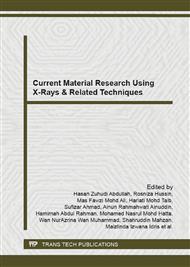[1]
A. Onojah, A. N. Amah and I.M. Echi, Polymorphs of Crystalline Silica from Rice Husk Ash. Journal of Basic Physical Research, (2012) 73 -75.
Google Scholar
[2]
R. Krishnarao, J. Subrahmanyam and T. J. Kumar, Studies on The Formation of Black Particles in Rice Husk Silica Ash. Journal of the European Ceramic Society, (2001) 99-104.
DOI: 10.1016/s0955-2219(00)00170-9
Google Scholar
[3]
J. Nayak and J. Bera, Effect of Sintering Temperature on Phase-Formation Behavior and Mechanical Properties of Silica Ceramics Prepared From Rice Husk Ash. Phase Transitions, (2009) 879 - 888.
DOI: 10.1080/01411590903471564
Google Scholar
[4]
Y. Shinohara and N. Kohyama, Quantitative Analysis of Tridymite and Cristobalite Crystallized in Rice Husk Ash by Heating. Industrial Health , (2004) 277-285.
DOI: 10.2486/indhealth.42.277
Google Scholar
[5]
A. A. Boateng and D. A. Skeete, Incineration of Rice Husk for use as Cementitious Material:The Gunaya Experience. Cement and Concrete Research , (1990) 795-802.
DOI: 10.1016/0008-8846(90)90013-n
Google Scholar
[6]
Y. Nakata, M. Suzuki, T. Okutani, M. Kikuchi and T. Akiyama, Preparation and Properties of SiO2 from Rice Husk. J Ceram Soc Japan , (1996) 842–849.
DOI: 10.2109/jcersj.97.842
Google Scholar
[7]
C. Real, M. C. Alcala and J.M. Criado, Preparation of Silica from Rice Husks. J Am Ceram Soc , (1996) 2012-2016.
Google Scholar
[8]
N. Hara, Utilization of Rice Husk Ash for Calcium Silicate Lightweight Building Materials. J Miner Soc Japan , (1988) 405-415.
Google Scholar
[9]
M. Higuchi and Y. Azuma, Effect of Alkali Metal Oxide Addition on Crystallization and Phase Transformation of Sintered Spherical Silica. J Ceram Soc Japan , (1997) 385-390.
DOI: 10.2109/jcersj.105.385
Google Scholar
[10]
A. M.Venezia, V. L. Parola, A. Longo and A. Martorana, Effect of Alkali Iions in The Amorphous to Crystalline Phase Transition of Silica. J Solid State Chem , (2001) 373-378.
DOI: 10.1006/jssc.2001.9345
Google Scholar
[11]
L. A. Bui, C. Chen, C. Hwang and W. Wu, Effect of Silica Forms in Rice Husk Ah on The Properties of Concrete. International Journal of Minerals, Metallurgy and Materials, 252 (2012).
DOI: 10.1007/s12613-012-0547-9
Google Scholar
[12]
E. P. Ayswarya, K. F. Francis, V. S. Renju and E. T. Thachil, Rice Husk Ash – A Valuable Reinforcement for High Density Polyethylene. Materials and Design, (2012) 1 – 7.
DOI: 10.1016/j.matdes.2012.04.035
Google Scholar
[13]
D. R. Lee, Characterisation and The Diagenatic Transformation of Non and Micro-Crystalline Silica Minerals. Department of Earth and Ocean Sciences, University of Liverpool, (2005) 1- 20.
Google Scholar


